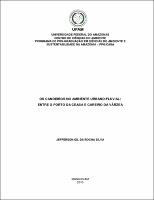| ???jsp.display-item.social.title??? |


|
Please use this identifier to cite or link to this item:
https://tede.ufam.edu.br/handle/tede/2569| ???metadata.dc.type???: | Dissertação |
| Title: | Os canoeiros do ambiente urbano-fluvial: entre o porto da Ceasa e Careiro da Várzea |
| ???metadata.dc.creator???: | Silva, Jefferson Gil da Rocha  |
| ???metadata.dc.contributor.advisor1???: | Scherer, Elenise Faria |
| ???metadata.dc.description.resumo???: | A beira-rio da cidade de Manaus abrange desde a foz do rio Tarumã até o rio Puraquequara. Num percurso de 43km de extensão, às margens esquerdas do rio Negro, encontram-se vários portos, públicos ou privados; outros pequenos e particulares, em geral, improvisados e ambientalmente degradados, que no intermédio entre o rio e a cidade movimentam a vida cotidiana dos manauenses e das populações que vivem nas cidades do entorno da capital. Entre eles, situa-se o porto da Ceasa, localizado na Zona Leste de Manaus. Ele faz parte da BR 319, que liga a capital a Porto Velho, além de outras regiões da Amazônia e do Brasil. Nesta dissertação, centramos nosso olhar no trabalho dos canoeiros que conduzem os pequenos barcos tipicamente regionais que transportam pessoas e mercadorias num intenso vaivém entre o porto da Ceasa e o porto do município do Careiro da Várzea, denominado de km 0. Nosso objetivo é caracterizar o trabalho cotidiano e o ambiente desse segmento dos trabalhadores que vivem no mundo da informalidade. Procuramos compreender sua identidade, sua importância para a mobilidade das pessoas e para a vida econômica regional. Esse porto tem uma importância fundamental na circulação da mercadoria produzida no Polo Industrial de Manaus PIM, por meio das balsas que atravessam o rio Negro e Solimões até o porto do Careiro da Várzea, do escoamento dos produtos regionais e da saída e chegada dos barcos que transportam os passageiros no sentido Manaus-cidades ribeirinhas do entorno da capital, e vice-versa. Ele é um lugar de confluência desses movimentos de ritmos intensos durante o dia. Além disso, é hoje um território ocupado por empresas e pelo denso trabalho informal em que se vende tudo: guloseimas regionais, peixes e frutas que chegam das zonas rurais do Amazonas. Nesse ambiente, estão os canoeiros conduzindo os seus barcos no movimento de ida e vinda, sob o sol e a chuva, enfrentando as intempéries regionais, sem horário fixo e com longas jornadas num ambiente urbano fluvial (in)sustentável e caracterizado pela improvisação, pelo descaso público ali demonstrado, configurando-se como palco de resistência do homem amazônico. |
| Abstract: | The waterfront city of Manaus extends from the mouth of the Tarumã river to the Puraquequara river. For a distance of 43 km long, at the left of the Negro river there are various ports, public or private, other small and private, generally improvised and environmentally degraded in the interim between the river and the city move the daily lives of manauense and people living in towns surrounding the capital. Among them, there is the port of Ceasa, located on the East Zone of Manaus. It composes and is part of the BR 319, that connects the capital till Porto Velho, and other regions of the Amazon and Brazil. In this thesis, we are focusing our attention to the work of the brigade leading the small boats typically regional that transport people and goods in an intense back-and-forth between the port of Ceasa till another one in the city of Careiro da Várzea, called Km 0. Our intention is to characterize the daily work environment and this segment of workers who live in the world of informality. We seek to understand its identity, its importance to the mobility of people and regional economic life. This port has a great importance in the movement of products done in the Industrial Pole of Manaus PIM, because of the ferries that across the Negro river towards the port of Careiro da Várzea, the marketing of regional products and the departure and arrival of the boats carrying passengers towards Manaus and cities surrounding the capital and vice versa. It is a place of confluence of these movements of intense rhythms during the day. Also, today is a territory occupied by dense business and the informal work where you can find everything: regional delicacies, fish and fruit that come from rural areas of the Amazon. In this environment are the leading canoe their boats in the movement back and forth under the sun and rain, facing the regional weather, with no fixed schedule and long hours in an urban river (in) sustainable and characterized by improvisation and the public neglect there demonstrated being stage of capacity of the Amazon man. |
| Keywords: | Trabalho Ambiente Travessia e Políticas Públicas Work Environment Crossing and Public Policy |
| ???metadata.dc.subject.cnpq???: | CIÊNCIAS AGRÁRIAS |
| Language: | por |
| ???metadata.dc.publisher.country???: | BR |
| Publisher: | Universidade Federal do Amazonas |
| ???metadata.dc.publisher.initials???: | UFAM |
| ???metadata.dc.publisher.department???: | Faculdade de Ciências Agrárias |
| ???metadata.dc.publisher.program???: | Programa de Pós-graduação em Ciências do Ambiente e Sustentabilidade na Amazônia |
| Citation: | SILVA, Jefferson Gil da Rocha. Os canoeiros do ambiente urbano-fluvial: entre o porto da Ceasa e Careiro da Várzea. 2010. 154 f. Dissertação (Mestrado em Ciências do Ambiente e Sustentabilidade na Amazônia) - Universidade Federal do Amazonas, Manaus, 2010. |
| ???metadata.dc.rights???: | Acesso Aberto |
| URI: | http://tede.ufam.edu.br/handle/tede/2569 |
| Issue Date: | 23-Mar-2010 |
| Appears in Collections: | Mestrado em Ciências do Ambiente e Sustentabilidade na Amazônia |
Files in This Item:
| File | Description | Size | Format | |
|---|---|---|---|---|
| DISSERTACAO JEFFERSON GIL.pdf | 18.43 MB | Adobe PDF |  Download/Open Preview |
Items in DSpace are protected by copyright, with all rights reserved, unless otherwise indicated.




